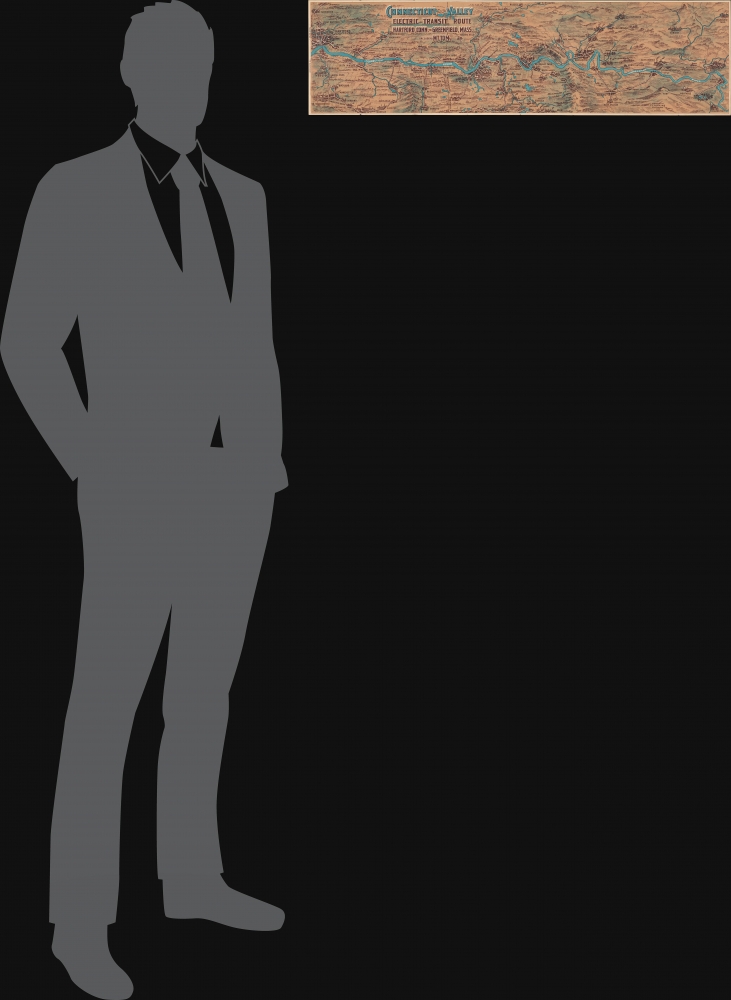1905 Sherman / Ottmann Bird's Eye View of Connecticut Valley
ConnecticutValley-ottmann-1905
Title
1905 (dated) 8 x 30.25 in (20.32 x 76.835 cm)
Description
A Closer Look
Oriented with north to the right, the view traces the lines of various companies operating lines in the Connecticut River Valley in white (lines under construction are marked with dashes), along with branch lines to nearby towns, cities, and attractions, namely Mt. Tom, the summit of which was reached by trolley. Mountains, hills, farmland, factories, cities, and towns are illustrated, with Springfield and Hartford standing out most prominently. Both cities emerged as manufacturing powerhouses in the years preceding this map's publication, making everything from sewing machines, automobiles, typewriters, motorcycles, and firearms to railroad cars. Text and photographs on the verso include descriptions of towns and cities served by trolley cars, as well as attractions like Mt. Tom and the casino at Forest Lake Park in Palmer, Massachusetts.Interurban Electric Streetcars or Trolleys
This view was a collaborative promotional piece issued by the Northampton Street Railway, Connecticut Valley Street Railway, the Holyoke Street Railway, the Springfield Street Railway, the Woronoco Street Railway, the Springfield and Eastern Street Railway, the Hartford and Springfield Street Railway, and the Hartford Street Railway. These lines began as an urban streetcar service in a given city but could travel at higher speeds on a separate right of way in rural areas, connecting to nearby cities. Known as a rural trolley, such services were distinct from, though functionally similar to, dedicated interurban trolley lines.In either case, electric trolley lines multiplied rapidly in southern New England in the brief period when electrification became widespread but before the automobile age. These lines were often short-lived, being acquired by competitors and consolidated into major companies, which were then subsequently incorporated into urban transit systems. At one point in the early 20th century, a traveler could take one of three separate interurban trolley routes between Boston and New York City.
Publication History and Census
This view was drawn by Ernest A. Sherman, printed by Jacob Ottmann, and published by Thomas C. Perkins in 1905. Information on Perkins is limited, but he was a businessman (investor and broker) and an active promoter of interurban electric trolleys. The OCLC notes this view among the holdings of the University of California Santa Barabra, Southern Methodist University, the Connecticut Museum of Culture and History, and the CW Mars library consortium based in Worcester, Massachusetts.CartographerS
Ernest A. Sherman (c. 1870 - 1917) was a designer, engrosser, draughtsman, and engraver based in Hartford, Connecticut. Details on his life and work are scant, but he is listed as an engraver in city directories and census documents beginning in 1894. More by this mapmaker...
Jacob Ottmann (March 4, 1849 - November 5, 1889) was a Prussian-American lithographer active New York during in the second half late 19th century. Ottmann was born in Meisenheim, Germany. He came to the United States in July of 1863 and was naturalized as U.S. Citizen on October 19, 1876. Ottmann, already a trained lithographer, joined Vincent Mayer and August Merket, 'Mayer and Merket,' around 1869. By 1874, Ottmann had built up enough equity and became a partner, with the firm changing its imprint to 'Mayer, Merkel and Ottmann'. The concern specialized in highly graphic color printed trade cards, and, by the 1800s, were a major American lithographic firm. Mayer and Merkel retired in 1885, leaving the firm to Ottmann, who renamed it 'J. Ottmann Lithographic' and in 1886 relocated to the Puck Building at 39 E. Houston Street. Ottmann must have begun to show signs of ill-health around 1888, when he composed and filed his will. In the following year, 1889, he applied for a passport to return to the Vaterland for a 'brief visit', but apparently never made it, dying shortly after receiving his passport. He is interred at Greenwood cemetery. After Ottmann's death in 1890, the firm was taken over by his son, William Ottmann, who shunted day to day management to Frank A. Bloom (1855 - 1901). Bloom ran the firm until his death in 1901, when it was acquired and became part of the United States Printing and Lithographing Company. Learn More...






